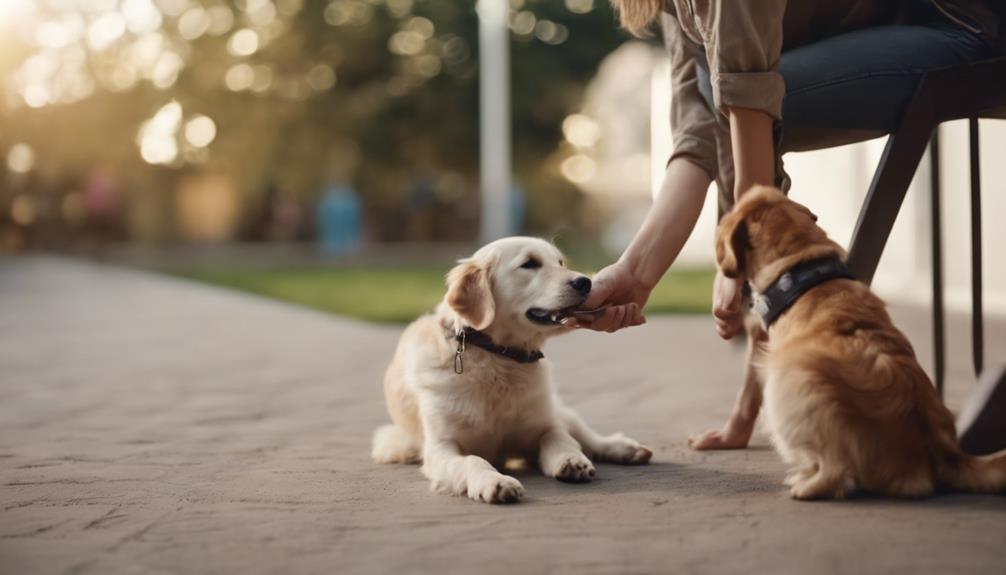Positive reinforcement is a cornerstone of effective dog training, fostering mutual understanding and respect between you and your pet. The key lies in incentivizing desirable behaviors through the strategic use of rewards, creating a harmonious environment conducive to learning.
However, mastering this technique requires more than just treats and praise; it demands a thoughtful approach and a nuanced understanding of your dog's psyche. By implementing six easy-to-follow tips rooted in positive reinforcement principles, you can unlock your dog's full potential and strengthen your bond in ways that go beyond mere obedience.
Key Takeaways
- Use positive reinforcement to teach and reinforce desirable behaviors effectively.
- Consistency and short, positive training sessions are crucial for success.
- Create a positive training environment by eliminating distractions and ensuring comfort.
- Utilize tools like treats, clickers, and toys to enhance the training experience for your dog.
Start With Basic Commands
To lay a solid foundation for effective positive reinforcement training, beginners should initiate the training process by starting with basic commands. Basic commands such as 'sit,' 'stay,' 'come,' and 'heel' are essential building blocks for shaping your dog's behavior.
These commands establish clear communication between you and your dog, setting the stage for more advanced training later on. By mastering these fundamental commands, your dog learns to focus, follow directions, and exhibit self-control.
Consistency and patience are key during this initial training phase, as it helps create a positive learning experience for your furry companion. Once these basic commands are well-established, you can then progress to more complex behaviors with confidence and a strong foundation in positive reinforcement techniques.
Use High-Value Rewards
When advancing your dog's training beyond basic commands, incorporating high-value rewards can significantly enhance motivation and reinforce desired behaviors effectively. High-value rewards are treats or toys that hold special appeal to your dog, making them more willing to work and learn during training sessions.
These rewards can be particularly useful for teaching complex commands or for reinforcing behaviors in distracting environments. Examples of high-value rewards include small pieces of cooked chicken, freeze-dried liver treats, or interactive toys that your dog loves.
Keep Training Sessions Short

Maintaining brief training sessions is essential for optimizing your dog's learning potential and fostering consistent progress in their behavior. To make the most out of your training sessions, consider the following tips:
- Prevent Burnout: Dogs, especially puppies and easily distracted breeds, have short attention spans. Keeping training sessions short helps prevent mental fatigue and ensures they stay engaged.
- Focus on Quality Over Quantity: Shorter, focused training sessions are more effective in reinforcing positive behaviors. It's better to have several short sessions throughout the day than one long session where your dog might lose interest.
- End on a Positive Note: By keeping sessions short, you can always end on a high, successful note, leaving your dog feeling accomplished and motivated for the next session.
Be Consistent and Patient
Consistency and patience are foundational pillars in successful dog training, ensuring reliable results and a strong bond between you and your canine companion.
Consistency involves using the same cues and commands to avoid confusing your dog. It's important to set clear expectations and stick to them to help your dog understand what is expected of them.
Patience is key as dogs, like humans, learn at their own pace. Rushing the training process can lead to frustration for both you and your dog. Remember to celebrate small victories and progress, showing your dog encouragement and support.
Eliminate Distractions During Training

To ensure effective training sessions with your dog, it is imperative to create an environment free from distractions. Distractions can hinder your dog's focus and make the training less productive. Here are three key steps to eliminate distractions during training:
- Find a Quiet Space: Choose a training location that is familiar to your dog and free from loud noises or other pets.
- Set the Right Timing: Ensure your dog has had a potty break and isn't too hungry or full before starting a training session.
- Minimize Interruptions: Keep kids, visitors, or other potential distractions away during training to help your dog stay focused on learning.
End Sessions on a Positive Note
Concluding training sessions with a positive reinforcement activity can leave your dog motivated and eager for the next session. Ending on a positive note helps solidify the bond between you and your furry companion.
Consider engaging in a fun activity your dog enjoys, such as playing with their favorite toy, giving them extra belly rubs, or offering a tasty treat. By associating the end of the training session with something enjoyable, you are reinforcing the idea that training is a positive experience. This approach encourages your dog to look forward to future training sessions and increases their willingness to participate actively.
Conclusion
In conclusion, employing positive reinforcement techniques in dog training can significantly enhance the learning experience for both you and your canine companion.
By following the tips outlined in this article, such as starting with basic commands, using high-value rewards, and maintaining consistency, you can create a positive and effective training environment.
Remember to keep training sessions short, eliminate distractions, and always end on a positive note to reinforce desired behaviors and strengthen the bond with your dog.




